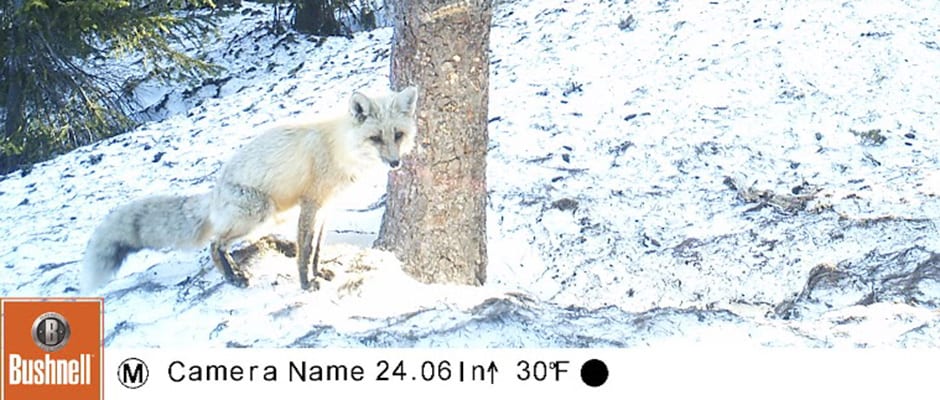Share this article
Forest Carnivore Project: Wild Cam Series
With the Sierra Nevada red fox (Vulpes vulpes necator) currently under review for a listing decision under the Endangered Species Act, researchers are working to obtain scientific knowledge about this subspecies in order to aid conservation efforts.
In a study that took place from 2012 to 2014 in the Oregon Cascades, researchers used camera traps to monitor forest carnivores including the Sierra Nevada red fox — one of the three subspecies of montane red foxes — and collected data to learn more about the elusive animal that had only previously been studied in California.
“There are several conservation challenges associated with the Sierra Nevada red fox, especially with the listing determination coming up,” said Tim Hiller, a researcher who started this Forest Carnivore Project while with the Oregon Department of Fish and Wildlife (ODFW), but is now with Mississippi State University, and member of The Wildlife Society. “We know very little about this subspecies in Oregon. Almost all of the other work has been conducted in California on two populations that total less than 50 individuals. There are many questions and unknowns related to the ecology of this subspecies, which may complicate the listing determination, like whether or how genetically distinct populations in Oregon are compared to the California populations.”
As part of the project, Hiller and his team (Jamie McFadden-Hiller and biologists with ODFW and the U.S. Forest Service) spent long days in brutally cold winter weather setting up traps and collecting hair samples at baited camera stations. This new Wild Cam photo essay presents some of the results of those efforts, offering a close-up of montane red foxes and other wildlife in the region.
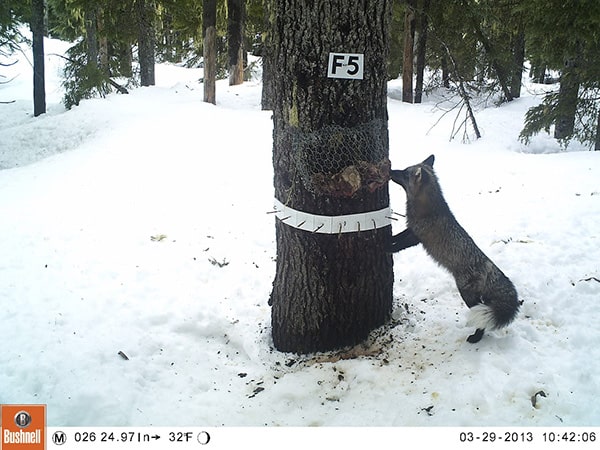
Image Credit: Tim Hiller and the Oregon Department of Fish and Wildlife
A Sierra Nevada red fox attempts to pull bait out of a hair-snagging device. The device, developed by biologists with the California Department of Fish and Wildlife, is fitted with gun-cleaning brushes to collect hair samples and bait enclosed in poultry netting. Preliminary genetic analysis showed that montane red foxes in the study area are the indigenous Sierra Nevada subspecies. This cross-phase Sierra Nevada red fox, named for the cross formation on its back, visited the station many times along with marten (Martes caurina).
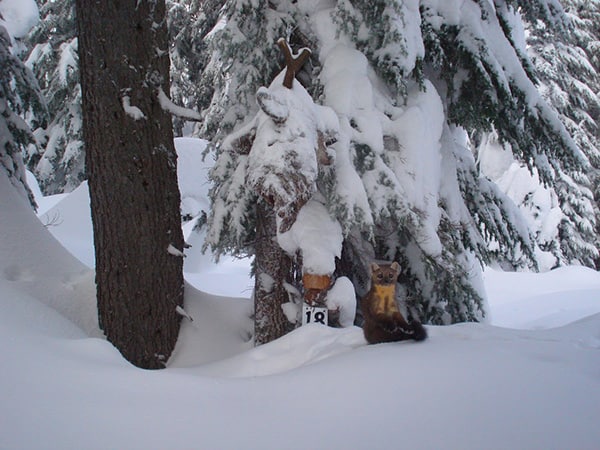
Image Credit: Tim Hiller and the Oregon Department of Fish and Wildlife
Deep snowfall might have proved challenging for researchers trying to maintain camera stations, but it didn’t hinder the region’s martens. In fact, martens showed up at 63 percent of all of the camera stations.
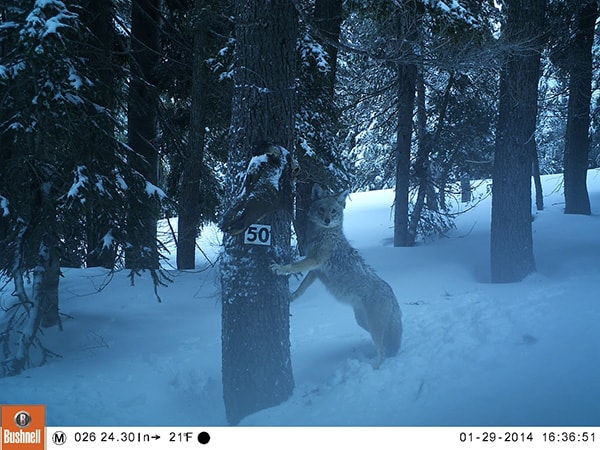
Image Credit: Tim Hiller and the Oregon Department of Fish and Wildlife
Coyotes were detected in many of the same areas as red foxes. In the second phase of their project, Hiller plans to explore coyote-red fox interactions in the montane systems. “The montane fox subspecies in California and Oregon are thought to be decreasing in distribution because of warming trends related to climate change,” Hiller said. “With climate and other factors becoming more favorable for coyotes, we want to find out how that may affect montane specialists, such as the Sierra Nevada red fox.” As gray wolves also expand their distribution in Oregon, Hiller said another interesting question is how these canids have potential benefits for the subspecies. “If we look at past literature, presence of gray wolves may be beneficial for these montane foxes,” he said. “We would expect some degree of population suppression or exclusion of coyotes. Coyotes are the montane foxes’ direct competitor, so we would expect that it would be beneficial.”
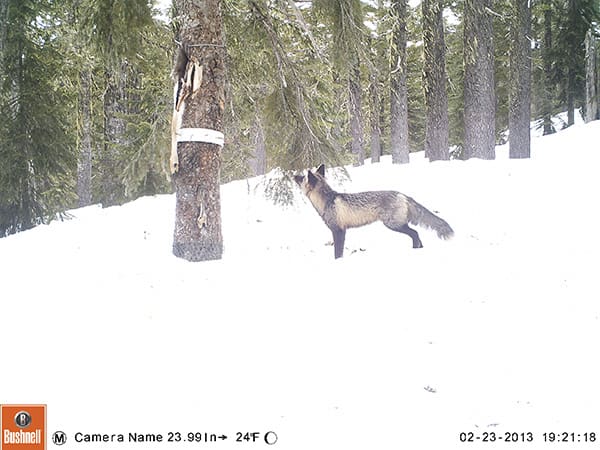
Image Credit: Tim Hiller and the Oregon Department of Fish and Wildlife
A cross-phase Sierra Nevada red fox was detected near Three Fingered Jack, a volcanic peak in the Willamette National Forest in the Oregon Cascades. Cross foxes are named for the darker portion of their fur across their shoulders and from their head to their tail, which, when viewed from above, resembles a cross.
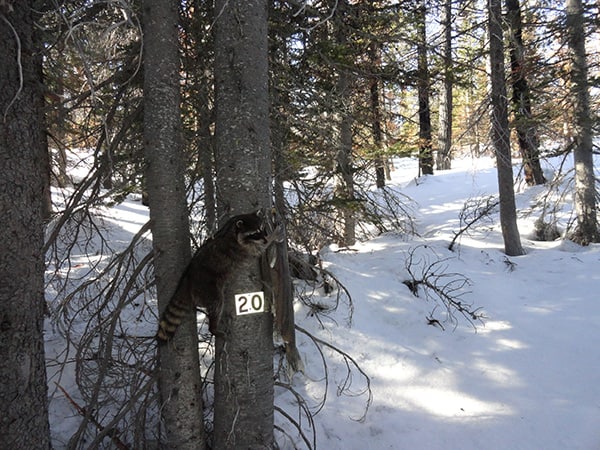
Image Credit: Tim Hiller and the Oregon Department of Fish and Wildlife
This northern raccoon, detected at almost 6,000 feet in elevation in the wintry Three Sisters Wilderness Area, is a rare sight since most raccoons stay at lower elevations. Given its location, researchers believe the raccoon’s presence was unlikely to have resulted from a human-assisted translocation.
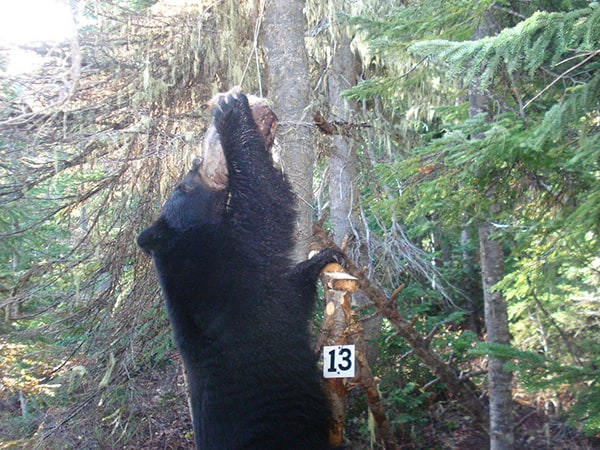
Image Credit: Tim Hiller and the Oregon Department of Fish and Wildlife
One of few detections of a black bear at a camera trap station in Three Sisters Wilderness. Because research was conducted primarily during winter in high-elevation wilderness, conditions were less suitable for bears to steal bait, and the few detections in each field season occurred when researchers were setting up bait stations during fall.
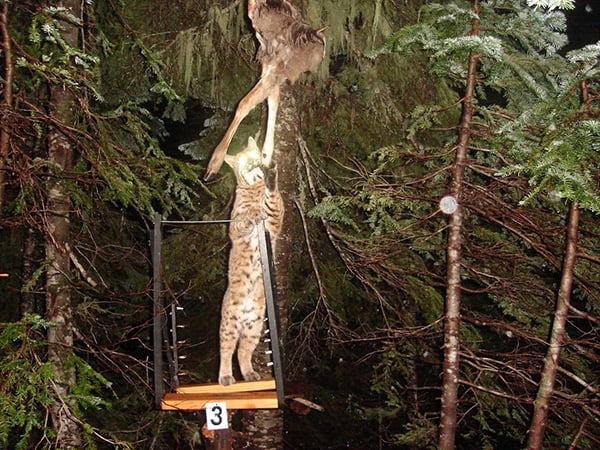
Image Credit: Tim Hiller and the Oregon Department of Fish and Wildlife
While the researchers set up an elevated bait station to obtain individual and sex identification of any wolverines that might be in the vicinity, this method apparently may also be appropriate for bobcats with some adjustments. The purpose of the bait station is to collect images and hair samples, using vertically mounted alligator clips, for genetic analysis.
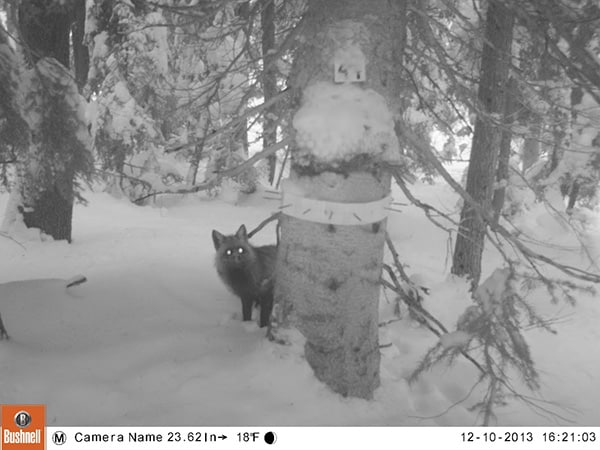
Image Credit: Tim Hiller and the Oregon Department of Fish and Wildlife
Many photos of montane red foxes were captured at night. This particular fox appeared to approach the bait cautiously, while other foxes seemed to aggressively feed multiple times at stations. Foxes were detected at 11 of the 41 ground-level camera stations. Overall, researchers collected over 700 photographs of the Sierra Nevada red fox over the span of the two-year project. They collected a total of 111,000 images, which included all different types of wildlife species. “We found a little bit more [Sierra Nevada red foxes] than we thought,” Hiller said. That included recreational areas, such as near Mt. Bachelor Ski Resort, where researches didn’t expect to find that consistently high level of fox activity within such close proximity to humans.
Currently, Hiller, along with Ben Sacks of the University of California, Davis, is in the next phase of the project in which they are working with ODFW, the U.S. Forest Service, and Crater Lake National Park biologists on scat searches and putting more cameras out in the Cascades. Rather than focusing only on wilderness areas, their study covers the entire Oregon Cascade Range from north to south. “As we get more samples, we can start answering questions about their population size and what makes them genetically distinct from those in California,” he said. “And we’ll look at their genetic integrity, such as any level of hybridization with non-native red fox subspecies, which we think are generally at lower elevations.”
This photo essay is part of an ongoing series from The Wildlife Society featuring photos and video images of wildlife taken with camera traps. Check out other entries in the series here. If you’re working on an interesting camera trap research project and have photos you’d like to share, email Joshua at jlearn@wildlife.org.
Header Image: Image Credit: Tim Hiller and the Oregon Department of Fish and Wildlife



